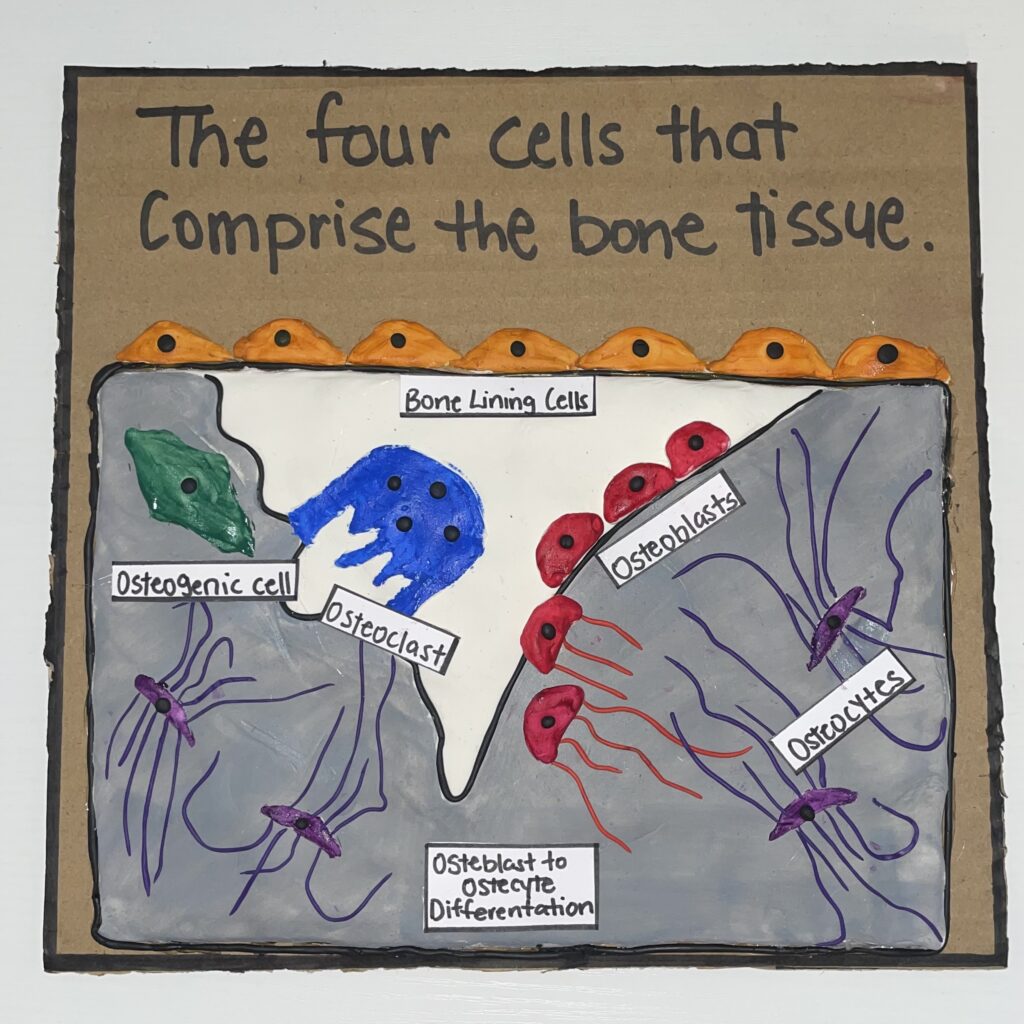

In this STEAM project, I will be focusing on the course objective of identifying the four cells that comprise bone tissue which are: Osteoblasts, Osteocytes, Osteoclasts, and Bone Lining Cells. To artistically showcase each cell, I used molding and painting techniques to identify each cell in the bone.
Specifically, osteoclasts are responsible for the dissolution and absorption of bone. They occupy small depressions on the bone’s surface and are formed by the fusion of many cells derived from circulating monocytes in the blood. (Britannica, 2014). The osteoclast, which is the sole bone-resorbing cell, is also a unique polykaryon whose activity, in the context of the osteoblast, dictates skeletal mass. All forms of acquired osteoporosis reflect increased osteoclast function relative to that of the osteoblast. (Pathol, 2007)
As a bone-building cell, the osteoblast is a crucial component in the process of bone formation and remodeling. It is responsible for both the synthesis and mineralization of bone and forms a tightly packed layer on the surface of the bone. To differentiate into an osteoblast, osteogenic cells in the periosteum and endosteum of the marrow cavity require a regular supply of blood. Without this supply, chondroblasts, which form cartilage, are instead produced. Osteoblasts create a variety of cell products, growth factors, hormones such as osteocalcin, and collagen, a vital component of the unmineralized osteoid in bone. As the bone matrix grows and calcifies around the osteoblast, it becomes trapped in a space known as a lacuna. The cell then transforms into an osteocyte and becomes a permanent part of the bone tissue. (Britannica, 2018)
Additionally, osteocytes, the cells present within the bone matrix, were inactive in comparison to the osteoblasts and osteoclasts that contribute to bone gain and loss. However, is it known that osteocytes play a critical role in regulating the dynamic nature of bone and are the main sensors for mechanical loading. Osteocytes produce factors that can initiate both bone formation and resorption, and they regulate local mineral deposition and chemistry at the bone matrix level. Moreover, they function as endocrine cells that produce factors targeting distant organs, such as the kidney, to regulate phosphate transport. It appears that osteocytes are the primary local orchestrators of many of bone’s functions. (Britannica 2020)
The bone lining cells are responsible for covering the inactive bone surfaces that are present in the adult skeleton. These cells are thinly extended over the surfaces of the bone and have flat or slightly ovoid nuclei. They can connect to other bone-lining cells through gap junctions and send cell processes into surface canaliculi. It is also worth noting that these cells can be induced to proliferate and differentiate into osteogenic cells and may represent the source of “determined” osteogenic precursors. Furthermore, bone lining cells found in the endosteal tissues may be an integral part of the marrow stromal system and could have important functions in hematopoiesis by controlling the inductive microenvironment. Since activation of bone remodeling occurs on inactive bone surfaces, it is possible that bone lining cells may be involved in the propagation of the activation signal that initiates bone resorption and bone remodeling. Lastly, bone lining cells play an important role in the maintenance of bone fluids and the fluxes of ions between the bone fluid and interstitial fluid compartments for mineral homeostasis. ( Miller, Saint-George, Bowman & Webster 1989)
In addition to all these bone cells, a disease known as Osteoporosis is linked to osteoblast and osteoclast. To maintain a strong skeletal structure, the bones in our bodies are constantly undergoing a process of remodeling and repairing. Unfortunately, there is a condition known as osteoporosis that can lead to a reduction in bone mass and deterioration of bone tissue. This can make bones more fragile and prone to fractures as we age. While osteoporosis is common as the body ages there is more osteoclast active and less osteoblast which repairs. One of the best ways to maintain healthy bone mass is through exercise, particularly weightlifting. Likewise, making healthy lifestyle choices like not smoking or misusing substances can also reduce your risk of developing osteoporosis. To further support bone health, consider incorporating vitamin supplements into your diet. Vitamins D, calcium, and K are all essential for maintaining strong bones and preventing weakness later in life. By taking these proactive steps, you can help ensure a healthy and active future. It’s important to take care of your bones and maintain a healthy lifestyle to prevent the onset of osteoporosis in one’s bones. (Lerner, 2006)
In conclusion, the bone is comprised of four cells. The artistic side of the STEAM project was to be creative and use an appropriate visual medium to demonstrate my objective while portraying the cells in the bone along with a written piece. I got to take a closer look at each of the four cells found in bone tissue and illustrate them, highlighting different details and I was surprised to see how each cell contributed to bone tissue in a unique way. Overall, I learned that Osteoblasts and Osteoclasts work together to regulate bone matrix, while Osteocytes signal them to function as they do. It’s amazing how complex our bodies are.
Sources:
Britannica, The Editors of Encyclopedia. “osteoclast”. Encyclopedia Britannica, 24 Jan. 2014,
https://www.britannica.com/science/osteoclast.
Britannica, The Editors of Encyclopedia. “osteoblast”. Encyclopedia Britannica, 15 Nov. 2018,
https://www.britannica.com/science/osteoblast.
Britannica, The Editors of Encyclopedia. “osteocyte”. Encyclopedia Britannica, 28 Feb. 2020,
https://www.britannica.com/science/osteocyte.
Miller, Scott C.; de Saint-Georges, Louis; Bowman, Beth M.; and Jee, Webster S. S. (1989) “Bone Lining Cells: Structure and Function,” Scanning Microscopy: Vol. 3: No. 3, Article 27.
Available at: https://digitalcommons.usu.edu/microscopy/vol3/iss3/27
Lerner, U. H. “Bone remodeling in post-menopausal osteoporosis.” Journal of dental research 85.7 (2006): 584-595.
https://www.healthline.com/health/is-osteoporosis-an-autoimmune-disease#diagnosis
Teitelbaum SL. Osteoclasts: what do they do and how do they do it? Am J Pathol. 2007 Feb;170(2):427-35.
doi 10.2353/ajpath.2007.060834. PMID: 17255310; PMCID: PMC1851862.
